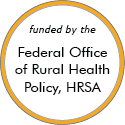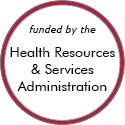Rural Project Examples: Behavioral health
Other Project Examples
Butte Child Evaluation Center

Updated/reviewed August 2024
- Need: Before 2000, Butte and southwest Montana saw around 1,300 cases of child abuse a year, with only a 20% conviction rate for perpetrators of sexual abuse.
- Intervention: Multiple agencies in the community came together to address the issue of child abuse by forming the Butte Child Evaluation Center (CEC), a Children's Advocacy Center.
- Results: During a 3-year grant cycle, over 200 interviews and exams were performed on victims of sexual abuse and the Butte CEC became the first program in Montana to be accredited by the National Children's Alliance.
Camp Mariposa
Updated/reviewed August 2024
- Need: To help children whose family members are struggling with substance misuse.
- Intervention: A year-round program provides mentoring as well as substance use prevention education.
- Results: In 2023, Camp Mariposa served a total of 113 youth in its four rural locations in Indiana, Kentucky, Tennessee, and West Virginia. In a study, 92% of participants reported no use of any substance to get high.
The Rural Outreach Center
Updated/reviewed July 2024
- Need: To expand services for individuals and families living in poverty in rural Western New York.
- Intervention: The Rural Outreach Center (ROC) offers care coordination, therapy, budgeting assistance, and multiple other services and opportunities to help address immediate needs as well as empower individuals to work toward long-term freedom from generational poverty.
- Results: The Rural Outreach Center serves approximately 250 adults and children each year through counseling, care coordination, and empowerment opportunities. The ROC reports that many participants have achieved and sustained goals related to housing, savings, employment, and other social determinants of health – which are also measures of poverty.
Florissa


Updated/reviewed June 2024
- Need: To address the developmental, behavioral, and social/emotional needs of rural children ages 0-22 in northwest Illinois.
- Intervention: Local partners teamed up to create a centralized service facility for children and families facing developmental, behavioral, and social/emotional issues. Florissa provides evaluations, diagnosis, and treatment to local children using a multidisciplinary, evidence-based approach.
- Results: In 2023, Florissa provided a direct clinical service to over 337 children, in addition to many trainings and supportive programs. It also is co-located with the KSB Hospital pediatric department, a certified pediatric patient-centered medical home (PCMH).
The Pennsylvania Medications for Opioid Use Disorder (PA MOUD) Technical Assistance and Quality Improvement Expansion Project
Added June 2024
- Need: To expand access to medications for opioid use disorder (MOUD) across the state of Pennsylvania.
- Intervention: An initiative formed to provide technical assistance aimed at improving MOUD treatment capacity and quality at healthcare sites across urban and rural Pennsylvania.
- Results: In 2023, 108 providers engaged with the program, treating a total of 5,185 individuals with MOUD. Currently, the program engages partners in 20 Pennsylvania counties – serving rural populations in Crawford, Schuylkill, Susquehanna, Butler, and Cambria counties.
First Day Forward

Added March 2024
- Need: Enhanced support for people with substance use disorders leaving jail and reentering communities in rural northeastern Kentucky.
- Intervention: A reentry program that uses peer support specialists to teach cognitive life skills, obtain essential identification documents, and help people create and follow personalized case plans before and after their release.
- Results: More than 420 people have been served by First Day Forward, with recidivism rates significantly lower among people who successfully completed the program.
Arukah Institute's Living Room Program

Added December 2023
- Need: To address high rates of substance use in Princeton, Illinois and the surrounding area.
- Intervention: The Arukah Institute, a local nonprofit organization providing mental health services, adapted a statewide model to provide support and a safe space for people in need of substance use resources.
- Results: The Living Room program had 1,485 visits in its first year, with 100% of clients served by recovery support specialists.
Schoharie County ACEs Team
Updated/reviewed December 2023
- Need: Agencies in Schoharie County, New York were seeing a widespread trend of Adverse Childhood Experiences (ACEs) in the children and families they served.
- Intervention: The Schoharie ACEs Team was formed as a way to educate rural communities about ACEs, the associated brain science, and ways to build resiliency.
- Results: The ACEs Team has put on 5 half-day educational conferences, 2 virtual conferences, and 10 trainings for various groups across the region. The team has also trained 3 school districts on trauma-informed care and provided resources for families exposed to trauma.
Healthy Men Michigan
Updated/reviewed November 2023
- Need: Mental health assessment and referral to resources for men in rural Michigan who struggle with depression and suicidal thoughts.
- Intervention: The Healthy Men Michigan campaign was a research study testing online screening for depression, including irritability and anger, and suicide risk in working-aged men. The Healthy Men Michigan campaign website also provided referrals to local and national resources specific to men's mental health and suicide prevention.
- Results: More than 5,000 individuals completed anonymous online screenings and 550 men enrolled in the study. Healthy Men Michigan secured partnerships with over 225 individual and organizational partners, including healthcare facilities, small businesses, and recreational groups across the state. Together, their efforts have helped to promote screenings, reduce stigma, and encourage help-seeking behavior to prevent suicide.
Richmond Substance Use and Mental Health Mobile Integrated Health Program
Added November 2023
- Need: To reduce the number of overdose deaths in Richmond, Indiana and connect people in need of mental health treatment to community resources.
- Intervention: A mobile integrated healthcare (MIH) program that connects social workers with people who have just experienced a mental health crisis or overdose.
- Results: More than 320 people have been referred to Richmond's MIH programs since June 2022.
For examples from other sources, see:
